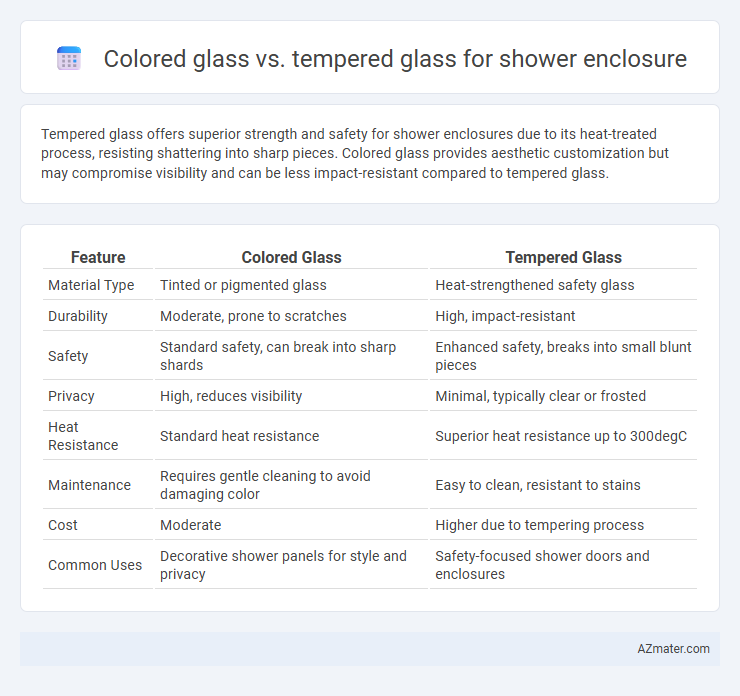Tempered glass offers superior strength and safety for shower enclosures due to its heat-treated process, resisting shattering into sharp pieces. Colored glass provides aesthetic customization but may compromise visibility and can be less impact-resistant compared to tempered glass.
Table of Comparison
| Feature | Colored Glass | Tempered Glass |
|---|---|---|
| Material Type | Tinted or pigmented glass | Heat-strengthened safety glass |
| Durability | Moderate, prone to scratches | High, impact-resistant |
| Safety | Standard safety, can break into sharp shards | Enhanced safety, breaks into small blunt pieces |
| Privacy | High, reduces visibility | Minimal, typically clear or frosted |
| Heat Resistance | Standard heat resistance | Superior heat resistance up to 300degC |
| Maintenance | Requires gentle cleaning to avoid damaging color | Easy to clean, resistant to stains |
| Cost | Moderate | Higher due to tempering process |
| Common Uses | Decorative shower panels for style and privacy | Safety-focused shower doors and enclosures |
Introduction to Shower Enclosures: Colored Glass vs Tempered Glass
Colored glass offers aesthetic customization and privacy in shower enclosures, enhancing bathroom decor with vibrant hues while providing moderate durability. Tempered glass, rigorously heat-treated for safety, delivers superior strength and shatter resistance, making it a reliable choice for high-traffic bathroom environments. Choosing between colored and tempered glass depends on the balance between design preference and safety requirements in shower enclosure installations.
Visual Appeal: The Aesthetic Impact of Colored vs Tempered Glass
Colored glass enhances shower enclosures with vibrant hues and customizable patterns, creating a unique focal point that elevates bathroom decor. Tempered glass offers a clear, sleek appearance that complements modern minimalist designs while maximizing light transmission. The choice between colored and tempered glass fundamentally influences the visual ambiance, balancing bold aesthetic statements with clean, transparent elegance.
Safety Considerations: Tempered Glass vs Colored Glass
Tempered glass offers superior safety for shower enclosures due to its heat-treated process, which makes it four to five times stronger than regular glass and shatters into small, blunt pieces that reduce injury risk. Colored glass, while aesthetically pleasing, often lacks the enhanced strength and safety features of tempered glass unless it is specifically manufactured as tempered colored glass. Prioritizing tempered glass ensures compliance with safety standards and minimizes hazards in wet, slippery shower environments.
Durability and Strength: Which Glass Type Performs Better?
Tempered glass outperforms colored glass in durability and strength due to its heat-treatment process, which increases resistance to impact and thermal stress. Colored glass, while aesthetically versatile, typically lacks the enhanced structural integrity of tempered glass and is more prone to breakage under pressure or sudden temperature changes. For shower enclosures, tempered glass provides superior safety and longevity, making it the preferred choice for durability and performance.
Privacy Options: How Color and Tempering Influence Opacity
Colored glass enhances privacy in shower enclosures by increasing opacity through pigmentation, effectively obscuring visibility while adding aesthetic appeal. Tempered glass, though primarily valued for safety due to its strength and shatter-resistance, usually remains clear or frosted, offering limited opacity without additional treatments. Combining colored glass with tempering produces a durable, privacy-focused shower enclosure that balances visual obstruction and structural integrity.
Maintenance and Cleaning Requirements
Colored glass shower enclosures require gentle cleaning products to preserve their hue and avoid surface damage, with mild soap solutions being preferred over abrasive cleaners. Tempered glass offers superior durability against scratches and is easier to maintain, typically needing standard glass cleaners and frequent wiping to avoid water spots. Both types benefit from regular squeegeeing after use to maintain clarity and extend the lifespan of the enclosure.
Installation Process: Comparing Colored and Tempered Glass
Colored glass for shower enclosures often requires specialized handling during installation to preserve the integrity of its pigmentation and prevent surface damage. Tempered glass, characterized by its enhanced strength and safety features, demands careful alignment and secure fixing to ensure the safety benefits are maintained. Installation of tempered glass typically involves precision cutting and fitting due to its resistance to alteration post-tempering, whereas colored glass can be customized pre-installation but may be more susceptible to chipping during the process.
Cost Analysis: Budgeting for Your Shower Enclosure
Colored glass for shower enclosures typically costs 15-25% more than clear tempered glass due to the added expense of pigmentation and custom fabrication. Tempered glass remains a cost-effective option, averaging $50-$100 per square foot, while colored variants can range from $65-$125 per square foot based on color complexity and manufacturer. Budgeting should consider installation fees, potential for increased maintenance of colored coatings, and the desired aesthetic impact on overall bathroom design value.
Customization and Design Flexibility
Colored glass offers extensive customization options with a variety of hues, opacity levels, and patterns, enabling unique and personalized shower enclosure designs. Tempered glass enhances design flexibility by providing superior strength and safety, allowing for larger and more intricate glass panels without compromising durability. Combining colored glass with tempered processing results in stylish, safe, and highly customizable shower enclosures tailored to individual aesthetic preferences.
Eco-Friendliness and Sustainability Factors
Tempered glass for shower enclosures offers superior durability and safety, extending product lifespan and reducing replacement frequency, which benefits sustainability by minimizing waste. Colored glass often requires additional chemical dyes and processing, potentially increasing environmental impact compared to clear tempered glass made from recyclable materials. Choosing tempered glass with eco-friendly coatings or low-emissivity treatments optimizes both energy efficiency and recyclability in sustainable bathroom designs.

Infographic: Colored glass vs Tempered glass for Shower enclosure
 azmater.com
azmater.com